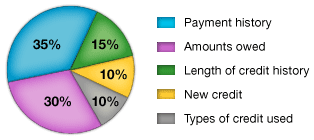What is a credit score?
A credit score is a mathematical model that evaluates the information in your credit file to come up with a score. A lender will use your credit score to determine whether you qualify for a particular credit card, loan, or service. Credit scores estimate the risk a company takes on by lending a person money or providing them with goods or services; specifically, your credit score tells the lender how likely it is that you’ll make payments on time over the next two to three year period. A high credit score means you’re a low credit risk with lower scores representing increased risk in the eyes of the lender.
What is FICO®
FICO® stands for Fair, Isaac and Company, the organization that devised the most popular form of Credit Score. As mentioned above, your FICO® Score determines the type of credit interest rates you’re offered.
The FICO® Scale
FICO scores are on a scale from 300 to 850. They are generally divided into 6 ranges that correspond to the interest rates issued by primary lenders.
The FICO Ranges are:
- 720-850 – gold, this where you aspire to be credit score-wise. If your credit score falls in this range there’s no reason that you shouldn’t be receiving the very best available interest rates.
- 700-719
- 675-699
- 620-674
- 560-619
- 500-599
If you’re in the 300-499 range you’re considered to be in the sub-prime or sub-lenders category. You can get credit but your interest rates will be higher and the restrictions on your spending will be greater.
What’s in your FICO® score
NOTE: The credit score information in this section summarized from the MyFICO.com website. Visit the site for complete details on how each of the following elements affects your credit score.
FICO Scores are calculated from a lot of different credit data in your credit report. MyFICO.com groups this data into the following 5 categories. The percentages reflect how important each of these credit areas is in determining your overall FICO score.

- Payment history: 35%,
- Amounts owed: 30%,
- Length of credit history: 15%,
- New credit: 10%,
- Types of credit used: 10%
According to MyFico you should be aware that:
- A FICO score takes into consideration all these categories of information, not just one or two.
- No one piece of information or factor alone will determine your score.
- The importance of any factor depends on the overall information in your credit report.
Keep in mind that while late payments lower your score, establishing or re-establishing a good on-time payment record increase your FICO credit score.
Credit Score Myths
There are many myths surrounding credit scores. Included among these are:
- Closing Credit Card Accounts Helps
- Checking Your Credit Score Hurts You
- Online Home Loan Shopping Dings You
- Paying off the highest interest rate cards first is best for your score
- Needless Disputing is a Good Practice
Check out the Video Credit Score website for great information (including videos) on what’s a myth and what’s reality with respect to your credit score.
Credit Card Abuse Issues
The US Public Interest Research Group (USPIRG) does a lot of research that calls attention to abusive credit card practices by credit card companies. Educate yourself on the issues facing credit card users and find out what you can do if you’re a victim of credit card abuse.


